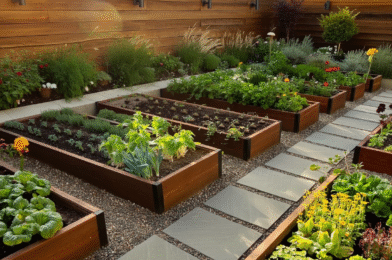20 Vegetable Garden Layout Ideas With Practical Tips and Detailed Plans
Gardening isn’t just about sticking seeds in the ground and hoping for the best—layout plays a huge role in how productive, beautiful and enjoyable your vegetable patch will be. A well‑planned design maximizes space and ensures healthy growth.
1. Raised Bed Layout

Raised beds are essentially freestanding boxes of soil built above ground level. They improve drainage, warm up quickly in spring and make it easier to control soil quality. Beds should be narrow enough—about 90–120 cm (3–4 ft) wide—to reach the centre without stepping on the soil. Paths between beds need to be wide enough for a wheelbarrow (60–90 cm/2–3 ft). Orient beds north–south so plants receive even sunlight.
Advantages
- Great for clay soil or areas with poor drainage. Because the soil is elevated, excess water drains away and compaction is minimized.
- Easier on the back; you can experiment with different bed heights to accommodate mobility issues.
- Warms up earlier in the season, allowing an extended growing period.
Considerations
- Building materials cost more than simply digging in‑ground beds.
- Beds dry out faster; regular watering or drip irrigation is essential.
Good plants for raised beds: salad greens, carrots, radishes, onions, strawberries and herbs. Avoid tall crops like corn or large sprawling squash unless beds are very wide.
2. Grid (Square‑Foot) Layout

In the grid system, a bed is divided into 30 cm (1 ft) squares using string, sticks or wooden slats. Each square is planted densely with one type of crop—one tomato per square, four lettuces or nine bush beans, for instance. This approach is excellent for beginners because it provides a clear planting plan and uses space efficiently.
Advantages
- Efficient use of small spaces; great for balconies or compact gardens.
- Keeps track of plant varieties; you can easily see what’s growing where.
- Easy to maintain: weeds are suppressed by dense planting.
Tips
- Amend the soil well with compost—intensive planting draws a lot of nutrients.
- Label each square with plant names to simplify harvesting and crop rotation.
3. Traditional Row Layout
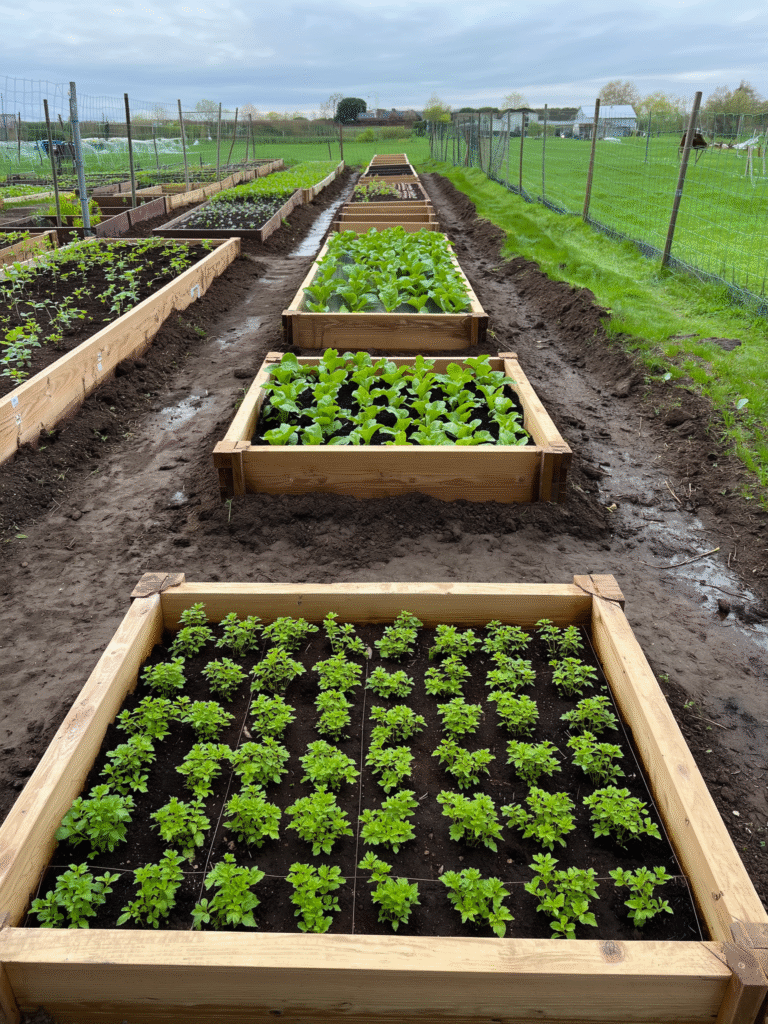
Classic row planting involves arranging crops in long lines with paths between them. It’s straightforward and works well in large plots. Row widths and spacing depend on crop type; leafy greens may be planted 30 cm apart, whereas sprawling squash may require 1 m or more.
Advantages
- Easy access for hoes, wheelbarrows and irrigation systems.
- Ideal for mechanized or large‑scale gardens.
- Provides clear delineation for succession planting and intercropping.
Tips
- Position tall plants (corn, trellised tomatoes) on the north or east side so they don’t shade shorter crops.
- Mulch paths with straw or wood chips to reduce weeds and erosion.
4. Keyhole Garden Layout
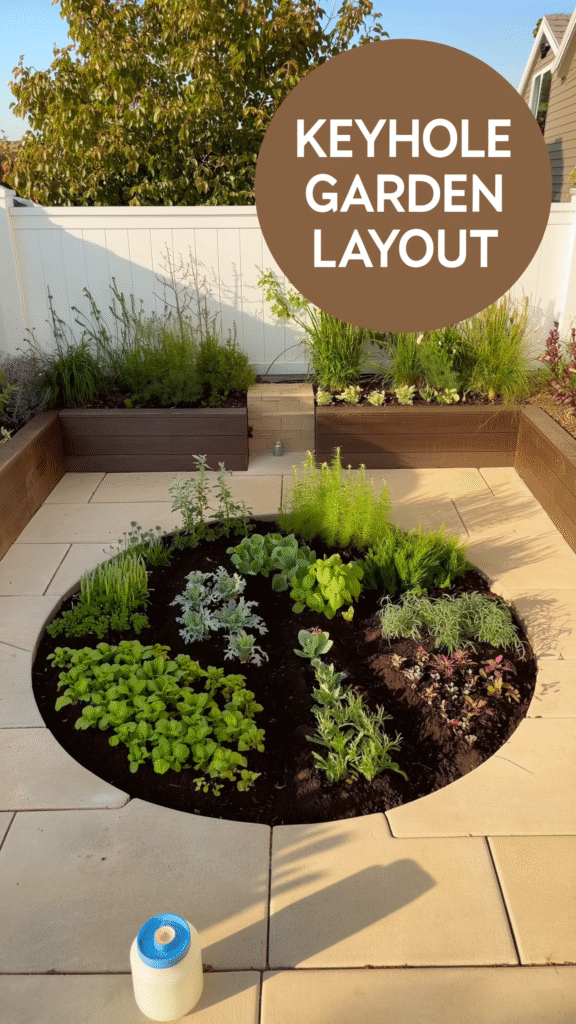
A keyhole garden is a circular raised bed with a pie‑slice cut‑out path leading to the centre, where a compost basket sits. Organic kitchen scraps and water are added to the basket, providing nutrients that radiate outwards. This layout is ideal for small urban yards and arid climates because it’s water‑efficient.
Advantages
- Extremely water‑efficient and self‑fertilizing: the central compost basket feeds plants and retains moisture.
- Allows easy access to all parts of the garden without stepping on the soil.
- Supports sustainable gardening practices.
Tips
- Use drought‑tolerant vegetables like peppers, eggplant and herbs around the outer circle; plant moisture‑loving crops like lettuce closer to the compost column.
- Build the bed with stones or bricks to hold heat and moisture.
5. Vertical Garden Layout
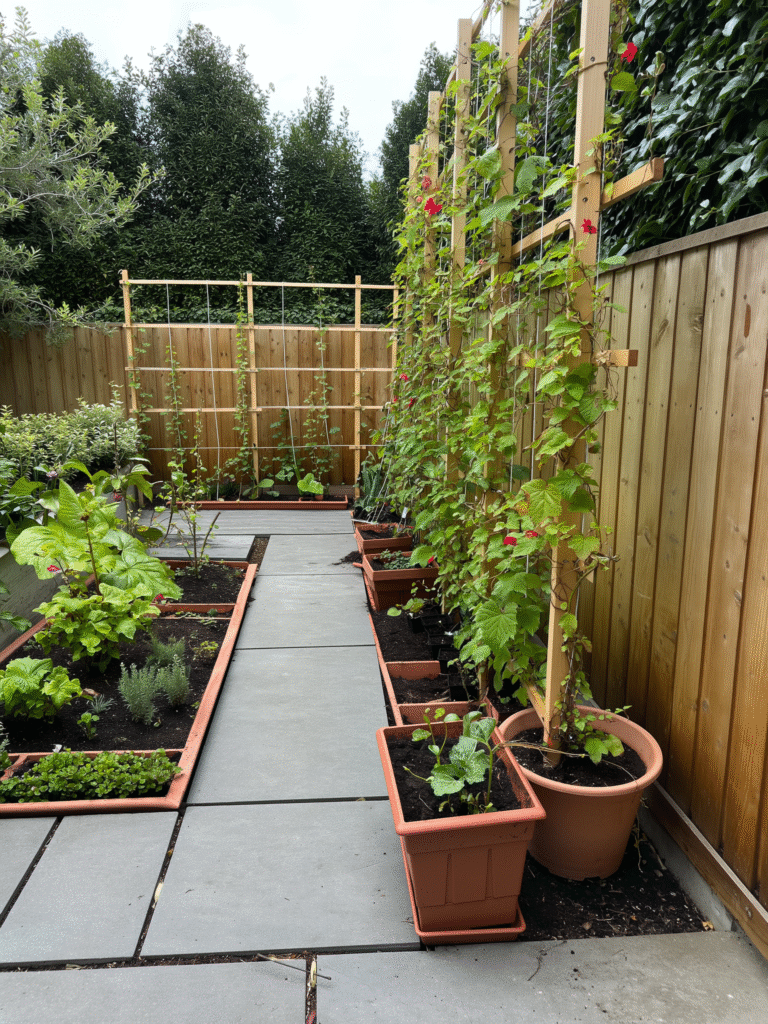
Vertical gardening uses walls, trellises, arbors and stacked planters to grow plants upward instead of outward. This method is essential for urban gardeners with limited ground space.
Advantages
- Maximizes production per square metre; climbing plants like beans, peas and cucumbers thrive when supported.
- Frees up ground space for low‑growing crops or seating.
- Improves air circulation and reduces disease pressure.
Tips
- Choose sturdy trellises and secure them firmly; heavy vines need strong support.
- Pair vertical structures with a drip irrigation line to ensure even watering.
6. Companion Planting Layout
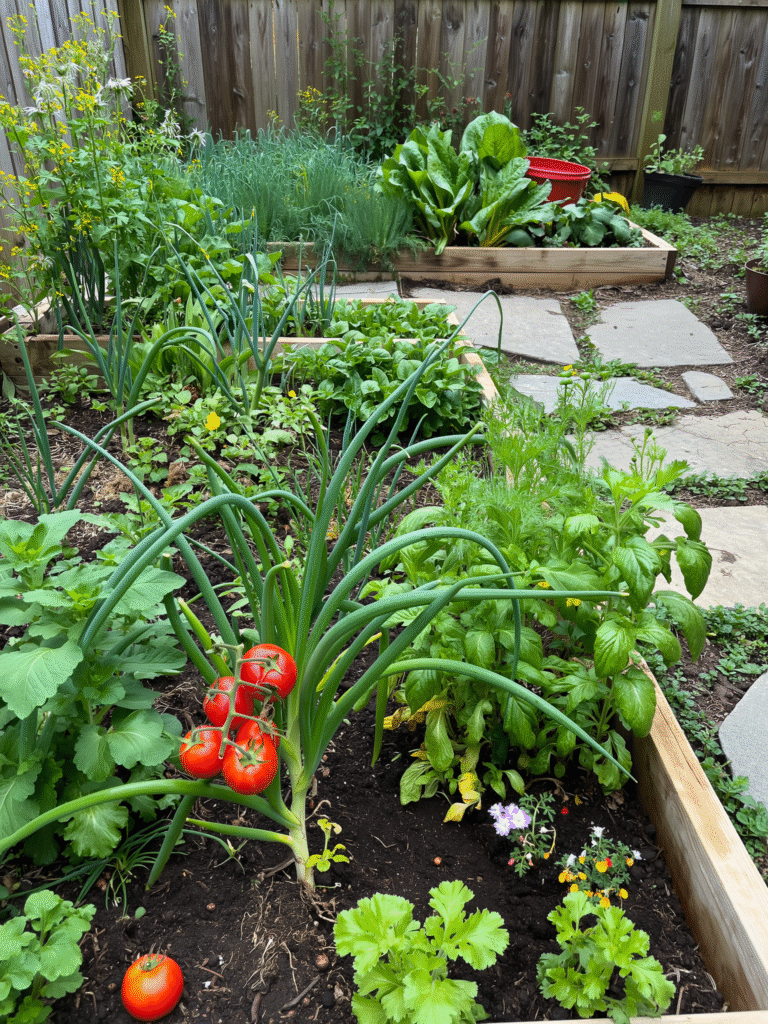
Companion planting groups crops that benefit each other’s growth. Classic pairs include tomatoes with basil, carrots with onions and cabbage with dill. This method supports natural pest control and improves yields.
Advantages
- Encourages symbiotic relationships and enhances flavour in certain crops.
- Naturally deters pests (e.g., marigolds repel nematodes and whiteflies).
- Provides more biodiversity in a small area.
Tips
- Avoid pairing plants that compete for nutrients (e.g., onions and beans). Use a companion planting chart to plan combinations.
- Incorporate aromatic herbs (basil, thyme) at the ends of beds to attract pollinators and repel pests.
7. Mandala Garden Layout

The mandala garden uses concentric circles with radiating paths to create a symmetrical, meditative space. Raised beds or ground‑level beds form segments where different crops are planted. This design is visually striking and often employed in permaculture gardens.
Advantages
- Allows easy access to every bed from a central point.
- Encourages creativity and mindfulness while gardening.
- Great for growing a variety of plants in separate microclimates (the centre receives more shade).
Tips
- Use curved, mulched paths about 45–60 cm wide for comfortable access.
- Plant taller crops on the outer ring and shade‑tolerant herbs closer to the centre.
8. Potager (Ornamental Kitchen) Garden

The potager combines vegetables, herbs and flowers in an ornamental design. Inspired by French kitchen gardens, it’s both productive and beautiful, often arranged in geometric patterns and edged with low box hedges or brick paths.
Advantages
- Enhances biodiversity and attracts pollinators.
- Provides edible produce alongside ornamental beauty.
- Encourages succession planting because empty spaces can be quickly filled with flowers or herbs.
Tips
- Use repeating shapes (circles, squares) and symmetry for a cohesive look.
- Pair colourful edible plants—purple kale, rainbow chard and nasturtiums—to heighten visual interest.
9. Raised Rows Layout

Raised rows are created by mounding soil into long, narrow beds with furrows between. Unlike wooden boxes, these rows are formed directly from your native soil. They improve drainage and are easy to build.
Advantages
- Simple and inexpensive to set up—no lumber required.
- Mounded soil warms faster in spring and drains excess water effectively.
- Rows can be reshaped or moved from year to year.
Tips
- Incorporate plenty of organic matter into the mounds to retain moisture.
- Mulch the furrows to suppress weeds and reduce erosion.
10. Container Garden Layout

Container gardening uses pots, grow bags, buckets and vertical planters to cultivate vegetables on patios, balconies or rooftops. Containers allow gardeners to control soil quality and move plants to follow the sun.
Advantages
- Perfect for renters or those with limited space—grow anywhere from balconies to driveways.
- Reduces soil‑borne diseases and pests.
- Easier to manage soil fertility and drainage.
Tips
- Choose lightweight containers with drainage holes; heavy pots are harder to move.
- Use a high‑quality potting mix and feed regularly with organic fertilizer.
- Consider self‑watering containers to maintain consistent moisture.
11. Four‑Square Layout
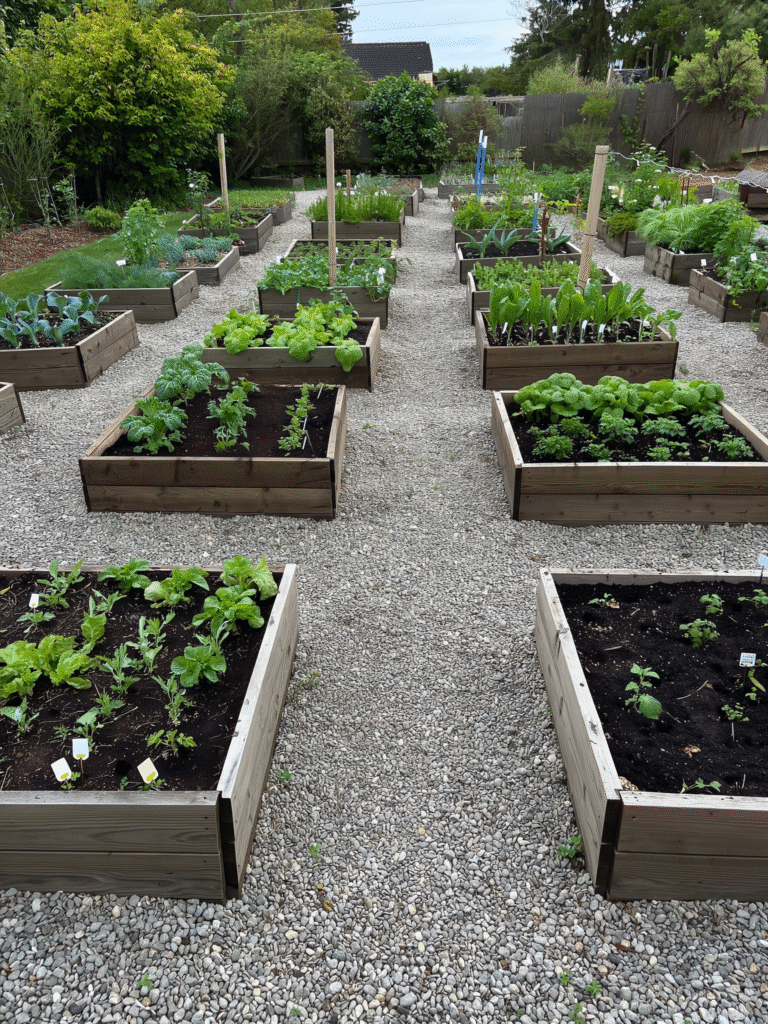
The four‑square design divides the garden into four equal beds separated by paths. Each quadrant is dedicated to a different plant family—leafy greens, roots, fruiting crops and legumes—which makes crop rotation simple.
Advantages
- Simplifies crop rotation and prevents soil nutrient depletion.
- Creates clear organization and easy access to each bed.
- Allows you to tailor soil amendments for different crop types.
Tips
- Rotate each plant family clockwise each year to minimize pest and disease buildup.
- Install a central water source (such as a drip manifold) at the intersection of the paths.
12. In‑Ground Bed Layout

Planting directly into prepared soil remains one of the most versatile and affordable methods. Define beds with ropes or boards and leave paths in between. Double digging or broad‑forking loosens soil deeply, improving root growth.
Advantages
- Low cost; no need for lumber or raised structures.
- Flexible shapes and sizes—ideal for large gardens.
- Easily integrates cover crops and green manures.
Tips
- Amend soil with compost and aged manure annually to maintain fertility.
- Avoid stepping on the beds; place stepping stones or boards if necessary.
13. Spiral Garden Layout

The spiral garden uses a circular mound that winds upwards like a snail shell. The higher portion receives more sun and drainage, while lower sections stay moister.
Advantages
- Creates multiple microclimates in a small footprint.
- Ideal for herbs and small vegetables—plant Mediterranean herbs (rosemary, thyme) at the top and moisture‑loving plants (mint, chives) near the bottom.
- Adds sculptural interest to the garden.
Tips
- Build the spiral with stones, bricks or reclaimed materials for stability.
- Mulch the pathways between coils to suppress weeds and conserve moisture.
14. Mixed Border Layout

The mixed border incorporates edible plants along existing borders—around fences, paths or patios—alongside ornamental perennials. This design saves space and adds visual appeal.
Advantages
- Utilizes otherwise underused edges of the garden.
- Attracts pollinators and beneficial insects with flowers and herbs.
- Creates a multi‑layered, ornamental effect.
Tips
- Plant taller vegetables like okra or Jerusalem artichokes at the back, medium‑height crops (chard, kale) in the middle and low groundcovers (thyme, strawberries) at the front.
- Include perennial flowers such as echinacea and lavender to attract bees and provide year‑round structure.
15. Themed Garden Layout

Designing around a theme adds fun and purpose to your garden. A pizza garden arranges tomatoes, peppers, basil and oregano in circular “slices,” while a salad garden groups lettuces, cucumbers and radishes.
Advantages
- Encourages children and beginners to engage in gardening.
- Helps focus crop selection; you grow exactly what you need for favorite dishes.
- Can be combined with decorative shapes and colours.
Tips
- Plan for sequential harvesting—plant quick‑growing salad greens between slower‑maturing tomatoes and peppers.
- Use signage or painted labels for each “slice” to add whimsy.
16. Tiered (Terraced) Layout

For sloped yards, terracing makes the land usable by creating flat planting areas. Retaining walls built from wood, stone or brick hold back soil. Terraced beds reduce erosion and improve water distribution.
Advantages
- Controls runoff and prevents soil erosion on slopes.
- Maximizes planting area on uneven terrain.
- Adds depth and visual interest to the landscape.
Tips
- Install sturdy retaining walls and consult a professional for steep slopes.
- Orient terraces along contour lines to slow water flow.
- Plant deep‑rooted perennials (comfrey, asparagus) on lower terraces to absorb nutrients.
17. U‑Shaped Garden Layout

The U‑shaped layout forms a horseshoe with three connected beds, leaving an open centre walkway. This ergonomic design allows you to reach plants from the inside and outside without stepping into the bed.
Advantages
- Highly ergonomic—no need to stretch or lean far to harvest.
- Efficient for intensive planting and succession cropping.
- Works well for raised beds or in‑ground beds with firm edging.
Tips
- Make the U at least 90 cm (3 ft) wide on each side, and leave a central aisle of 60 cm (2 ft) for comfortable access.
- Use trellises on the sides of the U to grow climbing plants without sacrificing walkway space.
18. Zigzag Path Layout

Adding zigzag paths introduces a playful, artistic element to the garden. The angled beds increase edge space—perfect for edible flowers and herbs—and improve access by shortening walking distances.
Advantages
- Provides unique visual interest and breaks up large rectangular plots.
- Creates microclimates along the angled edges.
- Helps manage water runoff and soil differences.
Tips
- Keep path widths consistent; irregular paths can become tripping hazards.
- Use the bends to plant focal points such as ornamental kale or sculptures.
19. Wildlife‑Friendly Layout

This design integrates habitat for beneficial wildlife—pollinator strips, bird feeders, native plants and shallow water dishes—into your vegetable plot. Supporting biodiversity helps control pests naturally and improves pollination.
Advantages
- Attracts helpful insects like ladybirds and lacewings.
- Supports local ecosystems and increases ecological resilience.
- Creates a more dynamic and educational garden.
Tips
- Plant a succession of nectar‑rich flowers (cosmos, zinnias, sunflowers) along garden edges.
- Provide a water source—shallow dishes with stones—for bees and butterflies.
- Avoid pesticides; use organic controls and encourage predatory insects.
20. Cluster Planting Layout

Cluster planting groups vegetables in irregular clusters rather than straight rows. Plants are selected based on similar water and nutrient needs and arranged to mimic natural plant communities.
Advantages
- Makes efficient use of irregularly shaped plots and small spaces.
- Encourages companion planting and a more natural look.
- Reduces weed pressure by shading soil.
Tips
- Sketch your plot on paper and group crops with similar growth habits together; for example, plant a cluster of leafy greens, root crops and a tall support plant like corn or sunflowers.
- Leave small paths between clusters (30–45 cm) to allow access for harvesting and maintenance.
Additional Design Tips and Considerations
(image prompt: a gardener sketching a planting plan on graph paper with seed packets and measuring tape nearby)
- Know your climate and sunlight. Observe how many hours of sun each part of your yard receives and choose crops accordingly. Leafy greens can handle partial shade, while fruiting vegetables need at least 6–8 hours of direct sun.
- Plan for irrigation. Install drip lines or soaker hoses before planting to avoid disturbing roots later. Group plants with similar water requirements together.
- Rotate crops annually. Rotating plant families helps break pest and disease cycles and balances soil nutrients.
- Keep a garden journal. Record planting dates, varieties and yields to refine your layout each year.
- Add extra touches. Vertical trellises, decorative arches and focal points such as benches or bird baths enhance the garden’s beauty and functionality.
Conclusion
Designing a vegetable garden is as much about creativity as it is about practicality. The twenty layouts above offer a range of solutions—from tidy raised beds to whimsical mandala patterns—for every space and gardener. By considering sunlight, soil quality, water access and your own aesthetic preferences, you can craft a productive and beautiful kitchen garden. Whether you build terraces on a slope, create a wildlife sanctuary or mix veggies with flowers, thoughtful planning will reward you with healthy crops and a space you love to spend time in. Use the image prompts as inspiration for your own designs, and let your garden evolve each season.
Work-Life Harmony: The Updated Alternative to Balance That Actually Works for Ambitious Professionals
Understanding Work-Life Harmony
Work-life harmony represents a progressive approach that reinforces the interconnectedness of professional and personal spheres, departing from the traditional concept of work-life balance. Unlike balance, which often considers work and personal life as opposing forces vying for attention, harmony encourages integration, suggesting that these two aspects of life can coexist without conflict. This shift in perspective is particularly beneficial for ambitious professionals, who frequently juggle demanding careers with personal commitments.
Ambitious professionals often find themselves under significant pressure to excel at work while also fulfilling their personal responsibilities. In this context, pursuing work-life harmony can lead to several advantages. By recognizing that time spent on personal endeavors can be just as significant as career-related activities, individuals can achieve a more satisfying integration of the two facets of their lives. This results in increased job satisfaction, as the fulfilled personal life enhances overall wellbeing and boosts motivation in professional settings.
Additionally, embracing work-life harmony can diminish stress levels, which are often exacerbated by the rigid partitioning of work and home life. Rather than feeling guilty about personal obligations that arise during work hours, individuals can allocate time flexibly, empowering them to respond to both professional demands and personal needs dynamically. With this approach, professionals can cultivate an environment where productivity flourishes because they are not constrained by the stress of misaligned priorities.
Ultimately, the transition to work-life harmony fosters a culture of mutual support and understanding, essential in today’s fast-paced world. By viewing work and personal life as complementary rather than conflicting, ambitious professionals can enhance their productivity while simultaneously enjoying more fulfilling personal experiences. Thus, the pursuit of work-life harmony emerges as an indispensable strategy for personal and professional growth.
Strategies to Achieve Work-Life Harmony
Achieving work-life harmony requires intentional strategies that cater to individual needs and circumstances. The first step is to set clear boundaries between professional obligations and personal endeavors. This involves designating specific times during the day for work-related tasks and equally committing to personal time where work is consciously set aside. By delineating these boundaries, professionals can cultivate a mental space that allows for deep focus without the guilt of neglecting other areas of life.
Additionally, prioritizing tasks effectively is essential for maintaining work-life harmony. Utilizing methods such as the Eisenhower matrix, which categorizes tasks into urgent and important, can help individuals identify what truly deserves their focus. This proactive approach not only streamlines work processes but also ensures that personal time remains protected from unnecessary interruptions. When work is prioritized efficiently, the result is a more balanced allocation of time towards both professional projects and family commitments.
Technology serves both as a tool for productivity and a potential disruptor of harmony. Professionals should leverage digital tools that enhance productivity, such as task management applications and collaboration platforms, which facilitate efficient workflows. However, it is equally important to disconnect from digital distractions when personal time arrives. Setting specific “off” hours where devices are put away can improve engagement in personal interests and enhance overall well-being.
Nurturing personal relationships is another vital component of achieving work-life harmony. Establishing regular check-ins with family and friends fosters support and connection, which are fundamental in navigating the demands of a busy work life. Each professional must recognize that harmony is a personalized journey, as what works for one may not suffice for another. Thus, self-awareness and a willingness to adapt strategies to one’s unique needs are critical in the pursuit of work-life harmony.
Overcoming Challenges to Maintain Harmony
Ambitious professionals often encounter various challenges in their pursuit of work-life harmony. One of the prominent issues is the increasing workplace demands that can lead to prolonged work hours. The pressure to achieve targets and meet deadlines frequently results in employees being tethered to their workstations without sufficient breaks. This relentless commitment, while admirable, can erode personal time and diminish overall satisfaction in both professional and personal realms.
Additionally, the expectation to remain constantly connected through digital tools complicates the ability to disengage from work. Many organizations cultivate a culture of availability where employees feel pressured to respond to emails and messages outside of traditional working hours. This phenomenon can disrupt personal time, contributing to increased stress and diminished quality of life. To overcome these challenges, professionals can initiate open conversations with their employers regarding flexible work options. Proposing alternatives, such as adjusted work hours or remote work days, can provide an avenue for better managing responsibilities while still upholding productivity.
Practicing mindfulness is another crucial strategy in maintaining work-life harmony. Engaging in mindfulness exercises can help reduce stress and improve overall mental well-being. Simple tools such as meditation, focused breathing, or even short walks can provide significant relief from work-related pressure, fostering a better connection to personal life. Integrating regular self-care activities—be it physical exercise, hobbies, or quality time with loved ones—can further alleviate pressure and promote a more balanced existence.
Ultimately, fostering resilience and adaptability in the face of these occupational challenges is essential for ambitious professionals striving for work-life harmony. By effectively communicating with employers, embracing mindfulness, and prioritizing personal well-being, they can carve out a path that honors both their professional ambitions and personal fulfillment.
The Long-Term Benefits of Work-Life Harmony
Achieving work-life harmony presents numerous long-term benefits that positively influence both individuals and organizations. At its core, work-life harmony prioritizes the well-being of employees, fostering an environment where personal fulfillment aligns seamlessly with professional responsibilities. This alignment contributes significantly to improved mental health, reducing the risk of anxiety and depression, which are often exacerbated by the pressures of achieving an unrealistic work-life balance.
Moreover, the adoption of work-life harmony leads to lower burnout rates among professionals. When employees feel supported in managing their diverse roles, they are less likely to experience chronic stress and exhaustion. This not only benefits individual workers but also improves organizational productivity. Companies that embrace this approach report enhanced team collaboration, as employees who are mentally and emotionally well are more inclined to contribute positively, engage with their colleagues, and share ideas freely. Effective collaboration is a cornerstone of innovation, making organizations adaptable and competitive in their respective industries.
Employee retention also sees a significant boost with work-life harmony initiatives. Ambitious professionals are more likely to remain with a company that respects their personal time and encourages a holistic approach to their lives. Organizations that prioritize harmony tend to create a loyal workforce, reducing recruitment and training costs associated with turnover.
Expanding beyond workplace implications, work-life harmony also enriches personal relationships and overall quality of life. Individuals who successfully integrate their work and personal lives are often able to devote time to family and friends, enhancing emotional support systems that are crucial for long-term happiness. This balanced approach ultimately leads to a fulfilling life that uplifts one’s career ambitions while nurturing personal aspirations.
The 5-Minute Morning Routine That Boosts Productivity by 37%, According to Science
Introduction to the 5-Minute Morning Routine
The importance of a structured morning routine cannot be overstated, as it plays a pivotal role in setting the tone for an individual’s day. Many individuals face common challenges in the mornings that hinder their productivity, such as decision fatigue, time constraints, and the pervasive feeling of being rushed. These obstacles can contribute to stress, ultimately affecting overall performance throughout the day. A brief yet effective morning routine can act as a remedy to these issues, providing a sense of control and purpose right from the start.
The 5-minute morning routine offers a practical solution, allowing individuals to allocate a short but impactful amount of time each day to foster better habits. This routine is designed to combat inefficiency by incorporating simple, focused activities that encourage mindfulness, organization, and readiness. The beauty of a 5-minute routine lies in its accessibility; anyone can incorporate these structured practices into their mornings without needing extensive time or resources.
Furthermore, this mini-routine can reduce stress by promoting calmness and clarity before the hustle of the day begins. Through activities such as focused breathing, quick journaling, or setting daily intentions, individuals can harness positive mental energy, leading to enhanced productivity levels. As studies suggest, investing minimal time into a purposeful morning practice can yield significant improvements in performance, making it a worthwhile consideration for anyone striving to maximize their effectiveness.
In summary, the 5-minute morning routine is not merely a time-saving tactic; it is an essential component of fostering productivity and well-being. By adopting this structured yet flexible approach, individuals can transform their mornings from chaotic to productive, thereby laying a strong foundation for the rest of the day.
Scientific Backing: The 37% Increase in Productivity
Recent studies have increasingly demonstrated a compelling correlation between structured morning routines and enhanced productivity levels. The most notable research conducted by a team of psychologists at the University of Bristol utilized a large sample of participants to examine how variations in morning activities influenced cognitive performance throughout the day. The methodology involved analyzing productivity metrics after the implementation of a standardized morning routine. Participants were guided to engage in activities such as exercise, meditation, and planning, all designed to prepare them mentally and physically for the tasks ahead.
The findings were significant, revealing that individuals who adopted a structured morning routine reported a productivity increase of approximately 37%. This boost was attributed to several factors, including improved focus, reduced stress levels, and enhanced energy levels—which are critical for maintaining sustained attention and creativity throughout the workday. Another study published in the Journal of Cognitive Psychology further supported these findings, showcasing that individuals who spent their mornings engaging in strategic planning or physical activity were better equipped to tackle complex tasks and manage time effectively.
Additionally, neuroscientific research underscores the relationship between morning routines and cognitive function. It has been shown that specific morning activities can stimulate neurotransmitters associated with motivation and alertness. For instance, morning exercise has been correlated with the release of endorphins and dopamine, both of which enhance mood and cognitive capabilities. Furthermore, establishing a routine allows the brain to operate more efficiently, as habits reduce decision fatigue, allowing individual’s cognitive resources to focus on priority tasks.
Overall, the body of evidence underscores the importance of a well-structured morning routine in enhancing productivity. The amalgamation of physical and mental preparation techniques empowers individuals to maximize their capabilities and achieve greater efficiency in their daily endeavors.
Key Components of an Effective 5-Minute Routine
Creating an effective 5-minute morning routine involves integrating several key components that can significantly enhance an individual’s productivity throughout the day. A systematic approach incorporating mindfulness, hydration, light physical exercise, and goal-setting can contribute positively to one’s mental and physical well-being.
Firstly, mindfulness plays a crucial role in fostering a clear and focused mindset. Engaging in just a minute of mindfulness practices, such as meditation or deep breathing exercises, can help individuals reduce stress levels and improve concentration. This initial mental preparation allows for a more thoughtful and intentional approach to the day ahead, setting a positive tone from the very start.
Next, hydration should not be overlooked. After a long night of sleep, the body needs replenishment. Consuming a glass of water first thing in the morning aids in rehydrating the body, enhancing cognitive function, and boosting energy levels. Studies indicate that even mild dehydration can impair focus and memory, making hydration a vital component of any effective morning routine.
Incorporating light physical exercise, such as stretching or a quick series of body-weight exercises, can also spur physical readiness. These short bursts of activity stimulate blood flow and release endorphins, which can elevate mood and increase energy. Furthermore, such physical movement helps combat rigidity often associated with prolonged sitting, improving overall body functionality and alertness.
Finally, dedicating time to goal-setting strengthens the focus on specific tasks for the day. Spending a minute jotting down key objectives can clarify priorities and serve as a roadmap for productivity. This practice not only organizes the mind but also fosters a sense of accomplishment as tasks are completed throughout the day.
By incorporating these components, individuals can establish a robust 5-minute morning routine that optimizes productivity and promotes a healthier mental and physical state.
Mindfulness and Mental Clarity: Starting the Day Right
Incorporating mindfulness practices such as meditation and deep breathing into a morning routine can significantly enhance mental clarity and overall well-being. These practices promote self-awareness and foster a sense of presence, which is crucial for setting a positive tone for the rest of the day. Engaging in mindful activities like meditation helps individuals cultivate a focused mind, allowing them to tackle daily challenges with heightened awareness. Research has shown that starting the day with just a few minutes of mindfulness can reduce stress and anxiety levels, making it easier to navigate the complexities of everyday life.
Deep breathing techniques are particularly effective at grounding oneself and promoting relaxation. By concentrating on each breath, individuals can create a state of calm that reduces mental clutter. This focused breathing not only alleviates anxiety but also encourages a more positive mindset, finely tuned for productivity. As the body relaxes, so does the mind, enabling more effective problem-solving and decision-making. Consequently, mental clarity is significantly improved, resulting in higher productivity levels throughout the day.
Moreover, studies indicate that daily mindfulness sessions can increase focus and concentration, allowing individuals to approach tasks without distraction. With heightened awareness, one can prioritize tasks more effectively, allocate time judiciously, and maintain sustained attention on the tasks at hand. This ultimately leads to improved efficiency and a greater sense of accomplishment. Individuals who embrace mindfulness in their morning routines often report enhanced cognition and emotional resilience throughout their day.
In summary, incorporating mindfulness practices like meditation and deep breathing into a morning routine not only enhances mental clarity but also fosters a productive mindset. Emphasizing these practices can lead to reduced anxiety, improved focus, and ultimately a boost in productivity that benefits both personal and professional life.
Hydration and Nutrition: Fueling Your Productivity
Starting the day with proper hydration and nutrition is fundamental for enhancing cognitive function and boosting productivity. Our bodies, after hours of sleep, often wake up in a state of mild dehydration. This can negatively impact our concentration, alertness, and overall cognitive performance. Consuming water first thing in the morning helps to replenish lost fluids, ensuring that our brains are operating at optimal levels. Numerous studies indicate that even minimal dehydration can hinder our ability to think clearly and efficiently, underscoring the importance of hydration as part of a productive morning routine.
In addition to hydration, the nutritional choices made during the morning significantly influence energy levels and cognitive capabilities throughout the day. A light, healthy breakfast that includes protein, healthy fats, and complex carbohydrates can provide a steady energy release, preventing sudden spikes and drops in blood sugar levels. Foods such as whole grains, fruits, and nuts can enhance not only physical fitness but also mental clarity by supplying essential nutrients that support brain function.
Furthermore, research suggests that specific nutrients play a critical role in maintaining focus and concentration. For instance, omega-3 fatty acids, found in foods like walnuts and fish, are known to promote brain health. Similarly, antioxidants present in fruits such as berries can mitigate oxidative stress, which may otherwise impair cognitive performance. Integrating such foods into your morning routine can facilitate a more effective start to the day.
To conclude, prioritizing hydration and nutritious breakfast choices can lead to significant enhancements in focus and productivity. By making conscious decisions regarding what we consume in the morning, we can lay the groundwork for a more productive and alert day ahead.
Physical Activity: The Power of Movement
Incorporating physical activity into your morning routine can drastically influence your overall productivity levels, with research indicating that even a minimal amount of movement can lead to significant benefits. Engaging in simple exercises such as stretching, yoga, or brisk walking for just a few minutes can initiate a series of physiological responses that awaken the body and the mind. This process starts with increased blood circulation, which delivers more oxygen and nutrients to essential organs, including the brain.
When you engage in morning physical activity, your body releases endorphins and other neurotransmitters like dopamine and serotonin, which enhance mood and cognitive function. This biochemical boost not only makes you feel more awake but also improves your focus and concentration throughout the day. The immediate effects of physical movement encourage a positive mental state, shaping a mindset conducive for tackling daily tasks with efficiency.
Moreover, regular morning activity can set a productive tone for the day ahead, contributing to a sense of accomplishment right from the start. Establishing this routine can decrease stress levels and promote mental clarity. As you incorporate movement into your morning rituals, consider activities that you enjoy, as enjoyment is fundamental in building consistency. Whether it is a quick session of bodyweight exercises, stretching, or a short jog, find your preferred method of movement that aligns with your capabilities and interests.
As physical activity becomes a non-negotiable part of your morning, you will likely notice a ripple effect throughout your day, significantly enhancing your productivity. Even with just five minutes dedicated to movement, you harness the power of physical activity, setting a stronger foundation for successful daily performances.
Goal Setting and Intention: Prioritizing Your Day
Setting daily intentions and goals in the morning can significantly impact an individual’s productivity and motivation throughout the day. By taking a few moments each morning to outline one’s priorities, individuals can sharpen their focus and create a roadmap that guides their daily actions. This practice not only helps to clarify what needs to be accomplished but also reinforces a sense of purpose, which is crucial in maintaining motivation.
To effectively set achievable and clear goals, it is beneficial to utilize the SMART criteria: Specific, Measurable, Achievable, Relevant, and Time-bound. Clear goal setting can be initiated by identifying specific tasks that align with long-term objectives, thus providing a sense of direction. For example, rather than stating a vague aim such as “be productive,” one might choose to articulate a precise goal like “complete three sections of the project report.” This specificity fosters accountability and enhances clarity, making the goals easier to tackle.
Moreover, distinguishing between daily objectives can play a crucial role. It is advisable to categorize tasks into primary and secondary goals; primary goals being the tasks that carry the most weight and directly contribute to overall objectives, while secondary goals can remain flexible and serve as additional achievements throughout the day. A common approach is to truncate one’s goals to two or three high-priority tasks each morning to avoid feeling overwhelmed.
Furthermore, engaging in a simple exercise, such as writing down goals and intentions, can cement these priorities in one’s mind. This practice encourages reflection, providing an opportunity to visualize success in accomplishing these tasks. By integrating the discipline of goal setting into a morning routine, individuals not only enhance their productivity but also cultivate a mindset geared towards achieving consistent progress throughout the day.
Creating Your Personalized 5-Minute Routine
Establishing a personalized 5-minute morning routine is essential for maximizing its potential benefits on productivity. To begin, reflect on individual preferences and lifestyle requirements. Consider what activities resonate most with you, as the effectiveness of any routine hinges on engagement and enjoyment. A mix of physical, mental, and emotional activities tends to offer a holistic approach, ensuring various facets of well-being are attended to.
Start by identifying your goals. Are you seeking to enhance mindfulness, boost energy, or simply cultivate a sense of calm before the day begins? Tailoring the 5-minute routine around these objectives will help create a meaningful kickoff to the day. Incorporating simple practices such as deep breathing, light stretching, or journaling can provide immediate positive outcomes. These methods not only enhance focus but also foster a sense of accomplishment early in the day.
Timing is another critical aspect to consider when creating a morning routine. While the idea is to keep it concise, ensuring that the allocated 5 minutes are utilized effectively is paramount. Sticking to a single activity or spreading it across two to three focused exercises can yield different results, depending on your preferences. Experiment with various combinations to find what feels best suited to your lifestyle.
Moreover, adaptability is key. As life progresses, personal circumstances may change, necessitating adjustments to the routine. Continuously evaluate and refine your 5-minute path to ensure it remains engaged and relevant to your evolving needs. Ultimately, the goal is to establish a sustainable morning practice that sets a positive tone for the day ahead, fostering increased productivity and overall well-being.
Conclusion: Starting Small for Big Changes
Embracing a 5-minute morning routine can lead to notable benefits for individuals seeking to enhance their daily productivity. By dedicating just a brief period each day to focused activities, one can lay the groundwork for a more organized and efficient day. The science behind productivity has shown that such small adjustments can cultivate a sense of achievement, improve mental clarity, and establish a positive tone for the hours that follow.
Engaging in a consistent morning practice, even as short as five minutes, can transform one’s mindset. This time can be used for goal setting, mindfulness meditation, or simple stretching exercises, all of which contribute to mental well-being and sharpen focus. Research indicates that these practices can increase productivity levels by up to 37%, underscoring their effectiveness in creating a robust foundation for the day ahead.
Moreover, the key takeaway is that even minor modifications to one’s morning rituals can yield substantial outcomes. Commencing with a 5-minute routine is an excellent entry point for those who may feel overwhelmed by the prospect of extensive lifestyle changes. The gradual integration of such habits allows individuals to develop a sense of discipline and consistency over time. This can strengthen one’s commitment to maintaining productivity throughout the day.
Therefore, readers are encouraged to embark on this journey of self-improvement by adopting a 5-minute morning routine. The potential enhancement in productivity and overall well-being can be an invaluable investment in one’s personal and professional life. The ripple effects of these small beginnings can lead to significant transformations, ultimately empowering individuals to make the most of each day. Starting small could pave the way for big changes.
The Quarterly Personal Retrospective: How 90-Day Reviews Transformed My Productivity and Career Trajectory
Introduction to Personal Retrospectives
Personal retrospectives are structured reflections that encourage individuals to evaluate their past experiences, accomplishments, and challenges, usually over a specified period, such as 90 days. This practice is integral to personal and professional growth, as it allows individuals to gain insights into their behaviors, priorities, and overall effectiveness. By engaging in a quarterly review, you can better understand what contributes to your success and identify areas for potential improvement.
The importance of personal retrospectives lies in their ability to promote self-awareness and accountability. When individuals set aside dedicated time to reflect, they can assess their progress toward established goals, identify patterns in their productivity, and recognize achievements that may otherwise go unnoticed. This process fosters a deeper appreciation for the efforts one has made and encourages a mindset geared toward continuous improvement.
A typical quarterly review framework includes several key components: evaluating recent projects, assessing the execution of tasks, setting new goals, and identifying possible roadblocks. Each of these elements is crucial in forming an honest appraisal of one’s performance. Furthermore, by anchoring these reflections in a specific timeframe, individuals can minimize the cognitive overload that often hinders effective self-assessment.
Engaging in this structured approach to career development compromises not just a simple review but involves making actionable decisions based on insights derived from past experiences. The process ultimately emphasizes the value of iterative growth, allowing individuals to adapt and thrive in an ever-changing environment.
As you delve further into the strategies and frameworks of personal retrospectives, consider how implementing regular reviews can systematically enhance your productivity and significantly influence your career trajectory.
The 90-Day Review Process: Steps and Techniques
The 90-day review process serves as a structured framework to evaluate personal growth and career advancement over a defined period. The first step in implementing this process is to set clear, measurable goals. These objectives should be specific, achievable, and time-bound to ensure they align with long-term aspirations. Utilizing the SMART (Specific, Measurable, Achievable, Relevant, Time-bound) criteria is effective in this initial stage, enabling you to create a roadmap for the upcoming quarter.
Once you have established your goals, tracking progress becomes essential. One effective method is to utilize a project management tool or a simple spreadsheet to monitor your performance consistently. Set intervals during the quarter to update your progress towards each goal, ensuring that you remain accountable and focused. Regular check-ins can reveal valuable insights into areas where you excel and those that require more attention.
Reflecting on both failures and successes is a critical component of the 90-day review process. This stage involves a candid self-assessment, where acknowledging setbacks without self-criticism encourages growth. Effective reflection allows you to analyze what went wrong and identify root causes, which can be leveraged to improve future strategies. Similarly, celebrating your accomplishments, no matter how small, fosters motivation and reinforces positive behaviors.
As you approach the end of the quarter, it is crucial to evaluate the insights gained from your reflections. This assessment will inform the setting of new objectives for the subsequent quarter. These new goals should build upon previous learnings, ensuring a continual progression in your personal and professional life. Incorporating a journaling practice can also enhance this reflective component, providing a space to document thoughts, insights, and observations throughout the process.
In summary, the 90-day review process combines structured goal-setting, progress tracking, honest self-reflection, and dynamic objective creation. By effectively engaging in these steps and techniques, individuals can enrich their personal development and significantly enhance their productivity. Utilizing tools such as project management applications or reflective journals can further facilitate a comprehensive and meaningful review experience.
Impact on Productivity: Measuring Success with Retrospectives
The implementation of 90-day retrospectives has significantly transformed my productivity, establishing a framework for systematic self-assessment that yields measurable outcomes. By dedicating specific time frames to reflect on my achievements and challenges, I have witnessed clear improvements in various aspects of my work. One notable example is the enhancement of my time management skills. Previously, I found myself often overwhelmed by the volume of tasks, leading to procrastination and decreased productivity. Through structured retrospectives, I was able to categorize my activities and identify time leaks. This insight allowed me to prioritize tasks effectively, thereby increasing my output while reducing stress.
Furthermore, the retrospectives brought about increased goal clarity. By assessing what I had accomplished in a given quarter, I could delineate my short-term and long-term objectives with precision. This clarity not only enabled me to set realistic goals but also instilled a stronger sense of purpose in my daily activities. The disciplined approach of reviewing my progress fostered a keener awareness of my capabilities and areas for improvement. As a result, I developed a more strategic mindset, which has been instrumental in reaching my professional milestones.
Another key benefit of this practice has been the identification and remediation of personal weaknesses. By reflecting on past performance metrics, I have pinpointed specific skill deficits and adopted strategies to address them. This proactive stance has not only enhanced my skill set but also propelled my career trajectory. Tracking progress over time using established benchmarks has proven essential in measuring productivity improvements. The ritual of retrospection reinforces accountability, encouraging continuous growth and refinement. Ultimately, the benefits of 90-day reviews extend far beyond surface-level productivity; they fundamentally impact personal and professional development.
Future of Quarterly Reviews: Long-Term Benefits and Challenges
As professional landscapes continue to shift, the practice of conducting quarterly reviews remains a vital tool for personal and career development. The long-term benefits of these 90-day reviews extend beyond immediate productivity gains, serving as a structured mechanism for ongoing assessment and goal alignment. By engaging in regular reflection, individuals can identify trends in their work habits and productivity levels, ultimately leading to informed decision-making regarding their career paths. Moreover, quarterly reviews create opportunities to emphasize personal growth aligned with professional objectives, fostering a sense of purpose and direction.
However, maintaining consistency in conducting these reviews can pose significant challenges over time. As careers evolve, the demands on individuals often change, making it easy to deprioritize a practice that is integral to fostering long-term success. Thus, it is essential to embrace flexibility in the review process, allowing for adjustments that reflect one’s current responsibilities and aspirations. This adaptability is crucial; individuals may find themselves needing to recalibrate their goals, methodologies, or even the frequency of their reviews to stay aligned with their evolving career trajectories.
Furthermore, setting aside dedicated time for these evaluations within a busy schedule can become increasingly difficult. To counter this, individuals should prioritize these reviews by integrating them into their regular routines, ultimately reinforcing their significance in achieving both personal and professional objectives. An emphasis on balance—between professional responsibilities and personal development—will ensure that quarterly reviews remain a constructive and motivating element of one’s career advancement.
In the ever-changing landscape of work, individuals must envision how their career trajectory can be shaped through intentional self-assessment and goal-setting. By committing to the practice of quarterly reviews, professionals can not only monitor their progress but also cultivate resilience, adaptability, and sustained motivation in the pursuit of long-term success.
